In February 2014, with the slogan “Defend Brooklyn” on the sleeve of his sweatshirt, filmmaker Spike Lee gave a Black History Month talk to an audience of art students at Brooklyn’s Pratt Institute. During the Q&A, one student asked if gentrification had its good sides. “I don’t believe that,” Lee replied, launching into a defense of his home neighborhood, Fort Greene, where, along with the surrounding neighborhoods, the white population had increased by 120%, while the black population decreased by 30% in the decade between 2000 and 2010. The rents, of course, went up.
Lee recalled his childhood, when the garbage wasn’t collected and police weren’t out protecting the streets. Addressing the question about gentrification’s good sides, he asked, “Why does it take an influx of white New Yorkers in the South Bronx, in Harlem, in Bed-Stuy, in Crown Heights for the facilities to get better?” He railed against what he called “the motherfuckin’ Christopher Columbus Syndrome,” the urban phenomenon in which newcomers, usually middle-class and affluent whites, believe they’ve “discovered” a neighborhood, as if nothing and no one had been there before them.
Since at least the 1980s, the enduring metaphor of gentrification has been colonialism. The frontier. Ed Koch might have started it when he called for the “new pioneers” to “come east,” reversing the “go west” of Manifest Destiny, that 19th-century idea in which settlers were destined, preordained by God, to expand ever outward into untamed territories, spreading Anglo-Christian culture and values, while ridding those territories of their people.
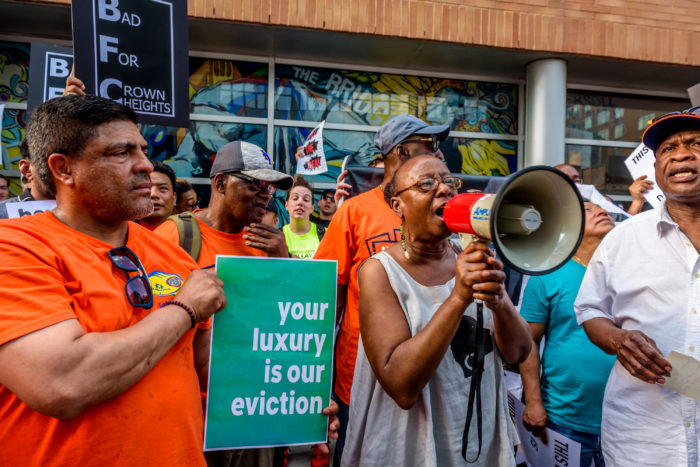
Crown Heights residents and housing advocates protesting a plan for the redevelopment of the Bedford-Union Armory that included luxury condos (Photo by Pacific Press/Alamy)
Journalist John O’Sullivan first defined Manifest Destiny in 1845 as the right to “overspread the continent allotted by Providence for the free development of our yearly multiplying millions.” This providentialism remains in America’s blood, linked back to Calvinism, to the Puritan colonists whose work ethic, with its belief in the preordination of wealth from God, formed the basis of American capitalism. We can feel it working today behind the revanchist takeback of the city.
The Frontier Myth in the City
Neil Smith, professor of anthropology and geography at the Graduate Center of CUNY until his death in 2012, outlined what is probably the most detailed and useful theory of gentrification and its changing shape. Writing on the frontier myth and gentrification, Smith explained how this mythologizing serves to cover up brutal realities. “As a new frontier,” he wrote, “the city bursts with optimism. Hostile landscapes are regenerated, cleansed, reinfused with middle-class sensibility” and “real-estate values soar.” Those who buy into the frontier myth tend to ignore or deny the human devastation that comes with it. When the poor and working class are repositioned, wrote Smith, “on the wrong side of a heroic dividing line, as savages and communists, the frontier ideology justifies monstrous incivility in the heart of the city.”
It is easy to cast the gentrifier of today as a one-dimensional villain. But what is a gentrifier? Are all gentrifiers monstrously uncivil, revanchist colonists? In the original definition, a gentrifier is a person from an upper-class group who moves to the neighborhood of a lower-class group. From there, it gets more complicated, but one thing is clear: Gentrifiers always have more social power than the people whose spaces they infiltrate. It may be the power of race, typically whiteness. It may be the power of class, which can sometimes be less visible. Seldom mentioned but important to note is the fact that many middle-class and affluent people of color are gentrifiers too, often in lower-income neighborhoods of color.
When talking about gentrification, we must keep intersectionality in mind. Sometimes all you need to be a gentrifier is the power of cultural capital. Penniless grad students from working-class backgrounds, actors and dancers working as waiters, black and Puerto Rican hipsters, and stylish queers all have cultural capital. And wherever City Hall and Big Real Estate look to commodify a new frontier, cultural capital is rapidly converted into economic capital. Which brings us to artists and gays.
Who Are the ‘Shock Troops’?
Artists are often branded as front-line gentrifiers. Sometime in the mid-1990s, people started saying: “Artists are the shock troops of gentrification.” The quote has been repeated about a hundred thousand times. Smith seems to have started it in his 1996 book, The New Frontier: Gentrification and the Revanchist City. “In the gentrification of the Lower East Side,” he wrote, “art galleries, dance clubs, and studios have been the shock troops of neighborhood reinvestment.” Not artists exactly. While they certainly play a role in the gentrification process—some more deliberately than others—it is inaccurate to equate artists with a powerful military operation. Worse, it distracts us from the real culprits.
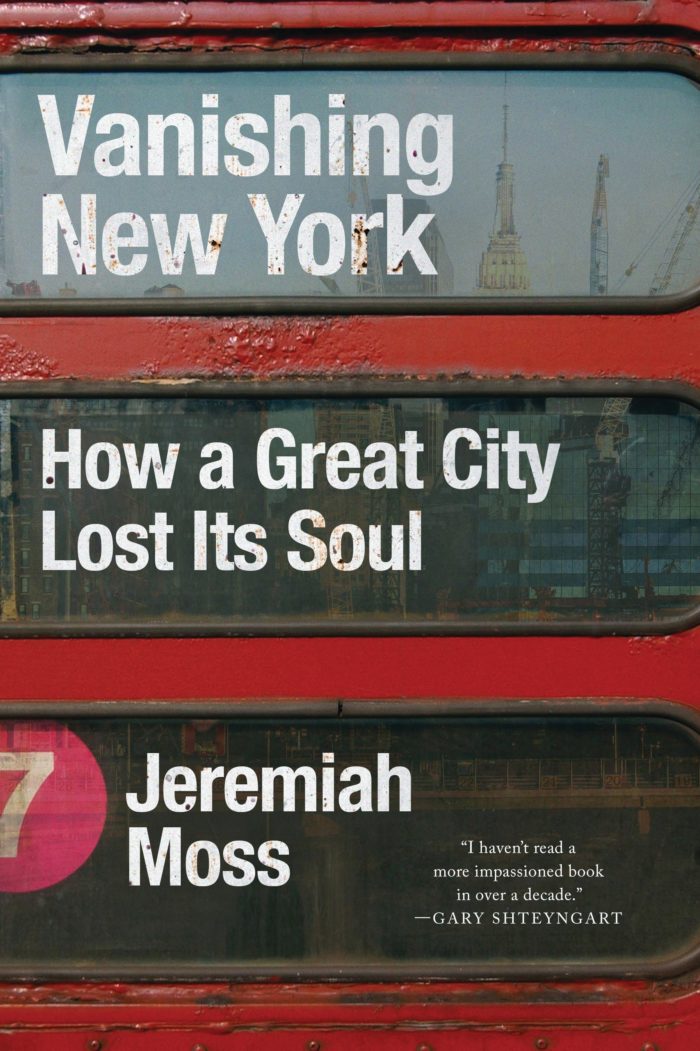
The author’s new book, based on his blog chronicling the city’s transformation
In Rebel Cities, CUNY professor and urbanist David Harvey points out how the people “who create an interesting and stimulating everyday neighborhood life lose it to the predatory practices of the real estate entrepreneurs, the financiers and upper class consumers bereft of any urban social imagination.” The more interesting the neighborhood, “the more likely it is to be raided and appropriated.” Artists are often unwitting tools of the hyper-gentrification machine. As Author Rebecca Solnit noted, it’s not the artists’ fault that yuppies and developers follow: “After all, creeps tend to follow teenage girls around, but teenage girls neither create nor encourage them.”
Except, of course, when artists do encourage them. There are many examples today of artists putting their work on “art walls” and in other installations co-branded with developers and corporations working to tame and commercialize contested zones. In the East Village, for one, the controversial Icon Realty in 2016 hired street artists to paint murals on the sides of buildings they took over, including the one from which they evicted the beloved Stage Restaurant. It was an obvious attempt to sway negative public opinion. In their press release about the mural by Jerkface, they hit all the key words, describing him as a local, native artist known for his “nostalgia-inducing murals.” We might want Jerkface to decline the commission, but how does a working artist turn down a paycheck in a city that has become unaffordable to artists? It’s another vicious cycle.
A new movement of artists fighting gentrification is growing. At a 2016 public discussion called “Artists: NYC Is Not for Sale,” artists and activists, mostly people of color, gathered to talk about their own role in gentrification—and how to break the cycle. South Bronx native Shellyne Rodriguez asked, “What can we do to shake the developer fleas off our asses?” The answer was simple: just say no. Under the social media tag #nycnot4sale, the group distributed a kind of manifesto, a brochure with a pledge to refuse collusion with real-estate speculators. It read: “To the developers, we are weapons of mass displacement. By loudly refusing this role, we can become weapons of creative resistance.”
Gay men and women have also been scapegoated as urban shock troops. As early as 1983, gay men were linked with gentrification when sociologist Manuel Castells in The City and the Grassroots made the connection between gay social clustering in San Francisco’s Castro district with neighborhood upscaling. But the situation was not simple. While many middle-class gay men, Castells explained, were renovating buildings, other, less well-off gay men lived in “organized collective households” and “were willing to make enormous economic sacrifices to be able to live autonomously and safely as gays.”
Less attention has been paid to the ways that lesbians create social space, and they’ve been less often implicated in gentrification. Due to economic inequalities, women, and queer women in particular, may have less control over the environment than men, but they still cluster. In the 1980s and ’90s, Brooklyn’s Park Slope was so full of lesbians it was affectionately known as “Dyke Slope.” By 2001 they were being pushed out. Said Cynthia Kern, producer at the time of DYKE TV, to Brooklyn Paper: “I moved to Dyke Slope when it was strong. Then it became Puppy Slope. Now it’s Baby Slope. We can’t fit between all the strollers there.”
Today, queer young people—many of them artists—are living in intentional, often racially mixed, housing collectives across gentrifying Brooklyn. In the past, they might have had a decade or more before hyper-gentrification found them, exploited their cultural capital, and pushed them out—along with their neighbors. Today it happens overnight.
For my own young artist friends, the East Village is now irrelevant. They’ve never even visited. They make their art and live their lives exclusively in Brooklyn. This looks like good fortune—finally, a real bohemian enclave in corporatized New York!—but locomotive hyper-gentrification is revving at their door. The kids are barely hanging on, already priced out as they price out those with less money and less cultural capital, attracting speculators and stroller pushers who push everyone deeper into the borough and beyond.
The Curse of the Creative Class
For the development-friendly cachet of artists and gays, some blame—or credit—urban studies theorist Richard Florida for his influential work on the “creative class.” In 2002, the same year that Bloomberg became mayor of New York, Florida published The Rise of the Creative Class and became an economic development guru. He laid out the “Gay Index” and “Bohemian Index” of cities, explaining how these groups would drive economic growth by attracting high-earning professionals into “talent clustering.”
The mayors of several cities heeded his advice. (Florida has since written that his ideas were often “misappropriated and misunderstood” by city leaders.) In the 2012 Financial Times op-ed “Cities Must Be Cool, Creative, and in Control,” Bloomberg wrote that cities must attract creative talent in order to compete for what he called the “grand prize” of tourists and businesses. A competitive city has to be cool, and that means bike lanes, those green veins that stream gentrifiers into low-income neighborhoods, along with art galleries, free Wi-Fi, and public spaces turned into semi-privatized “creativity” zones where hip professionals interact with global brands.
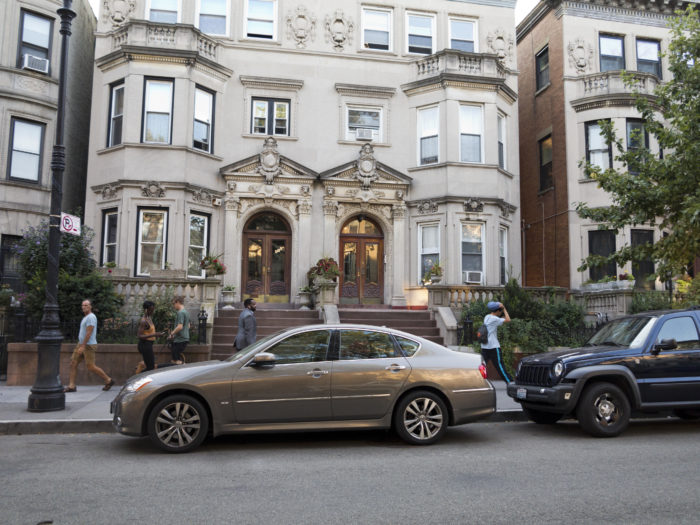
The grand housing stock of Bedford-Stuyvesant has helped make it a new hotbed of gentrification (Photo by Ethel Wolvovitz/Alamy)
Florida’s creative-city idea has its critics. Urbanist Jamie Peck argues that creativity strategies become policy in part because they “work quietly with the grain of extant ‘neoliberal’ development agendas, framed around interurban competition, gentrification, middle-class consumption and place-marketing.” Creativity agendas can deceptively feel lefty, like old Jane Jacobs with her diversity and vibrancy and mixed use. As Peck points out, they “have an apple-pie quality,” generating support while disarming opposition. It’s hard to critique this stuff. Who doesn’t like public art, free Wi-Fi, and other nice things? Bread and circuses are an effective way to control opinion.
When I criticized the High Line, I was attacked as a heretic. And don’t dare complain about bike lanes. Look, I enjoy riding in the bike lanes, but I’m not going to deny that they’re a tool of hyper-gentrification, attracting a certain class of people (to which I belong) and giving a boost to property values, facts that Mayor Bloomberg’s transportation commissioner knew well. Let’s at least engage critically with these things we enjoy. Sometimes a latte is not just a latte.
Is There a Trickle-down Effect?
When assessing urban improvements, we must always ask: Who is it for? Who is it meant to attract and who will it displace? As Florida himself warned in 2002, the impact of high-earning professionals on existing inner-city residents would be to “raise their rents and perhaps create more low-end service jobs.” The classes and, for the most part, the races would not mix. His prediction proved correct. “On close inspection,” he wrote a decade later, “talent clustering provides little in the way of trickle-down benefits.” It’s good for high-skilled professionals, but not for the poor and working class.
Florida has been rethinking his theories, and those city leaders who followed his original advice would do well to listen. In 2016, speaking on the topic of his new book, The New Urban Crisis, he said, “I could not have anticipated among all this urban growth and revival that there was a dark side to the urban creative revolution, a very deep dark side.” He continued, “The urban pessimists have a point. We neglected their point, which is that cities are gentrifying, people are being priced out, displaced from their homes.”
To read more of our reporting on gentrification, see our stories on Bedford-Stuyvesant, Nostrand Avenue, Brownsville and Gowanus.
When the real culprits are the city leaders who serve corporate and real-estate interests, let’s stop pointing the finger at struggling artists and queers. Imagine what would happen to the creative and iconoclastic character of the city—and the nation—without these populations. As Rebecca Solnit wrote, “A city without poets, painters, and photographers is sterile. … It’s undergone a lobotomy.” The system today is such that even the most compassionate young queer poet—imagine her: dedicated to social justice, organizing with Occupy Wall Street and Black Lives Matter, working as a barista in the feminist cooperative bookshop—even she finds herself with little choice but to be a gentrifier, moving to a low-income neighborhood because that’s what she can a afford and her social network is there. And what about me? I’m a white, educated, middle-class professional. If I leave my rent-stabilized apartment, where will I go? Someplace, no doubt, where I will be a gentrifier.
Hipsters: Not the Underdogs
And what of the hipsters? No discussion of today’s Brooklyn can avoid the hipster. Hipster is an old word, but in the book What Was the Hipster? Mark Greif places its contemporary rebirth in the year 1999. Unlike bohemian or punk of the past, hipster, according to Greif, identifies a “subculture of people who are already dominant.” These are not your underdogs carving out a place to breathe free. The modern-day hipster “aligns himself both with rebel subculture and with the dominant class.” The hipster is thus the “rebel consumer” who rebels against nothing, the so-called artist who creates no art.
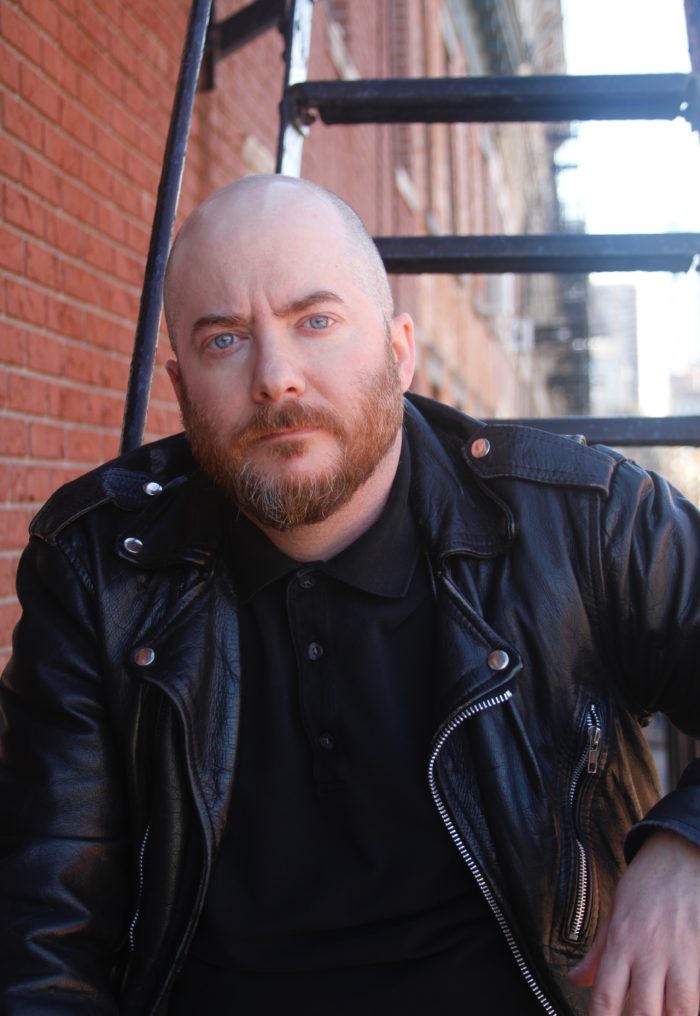
The author, who wrote his blog under a pseudonym, disclosed his real identity with the publication of his book (Photo by Christopher Schulz, courtesy of Dey St. Books)
The hipsters who flooded Brooklyn (and the entire Western world) in the 2000s might look like bohemians, says Greif, but they are not. They are not anti-authoritarian, like other youth subcultures through history. They drink the Kool-Aid of corporate consumer culture as they adopt a fauxhemian style. In a related essay in New York, Greif noted how hipsters can be found mixing with “anarchist, free, vegan, environmentalist, punk, and even anti-capitalist communities.” The hipster thus infiltrates, appropriates, and commodifies these countercultures, creating elite trends and brands in collaboration with consumer culture.
It was through this process of hipsterization that the New Brooklyn brand was developed and globally disseminated, filling cities with carbon copies of its high-priced coffee bars, rooftop beehives, lumbersexual chic, hyperlocal fetishism, neo-primitive interior design of the rustic and repurposed, curly mustaches and the wax to go with them, all that is twee, all that is “artisanal” and “small batch” and “bespoke.” Places and products are now branded “Brooklyn” across the world. Paris even has an ersatz diner named after Williamsburg’s Bedford Avenue, the fountainhead of hipsterism (and now one of the most expensive retail corridors in America). Brooklyn has become a global consumer movement born from one neighborhood that was “discovered,” became trendy, and then went supernova when the city government and its developer pals swooped in with big plans.
In her book A Neighborhood That Never Changes, urban ethnographer Japonica Brown-Saracino divides gentrifiers into three types: 1) Pioneers, who “celebrate gentrification’s benefits and unabashedly welcome the transformation of the wilderness” as they “seek financial gain”; 2) Social Preservationists, who “work to preserve the character of their place of residence” and seek to prevent displacement; and 3) Social Homesteaders, who are neither Pioneers nor Preservationists, but a combination of the two: “They appreciate authenticity …but gentrification’s cost for longtime residents and their communities are not their central concern.”
All three types benefit from gentrification, and the social preservationist (the category with which I personally identify) also contributes, however unwillingly, to displacement. As Brown-Saracino points out, “preservationists’ presence in a gentrifying area—whether because of their race, relative affluence, or cultural capital—signals to others that it is safe and desirable and, thus, invites further investment by homeowners, businesses, and local government.”
Furthering the Displacement
A middle-class white person in a low-income neighborhood, especially a neighborhood of color, is like a drop of blood in a pool surrounded by circling sharks. We have to do something about the sharks before they get in. Unfortunately, many gentrifiers eagerly chum the waters. They are what we might call gentrificationists, not just celebrating but actively advocating for neighborhood turnover. When they talk and tweet about the amazing new restaurants, and good riddance to that smelly old (fill in the blank), and Dear Starbucks: Can you please open shop in (fill in the blank) because there is no place for blocks to get a good cup of coffee, etc., people are actively working to further the process of displacement. How we talk about the city has an impact.
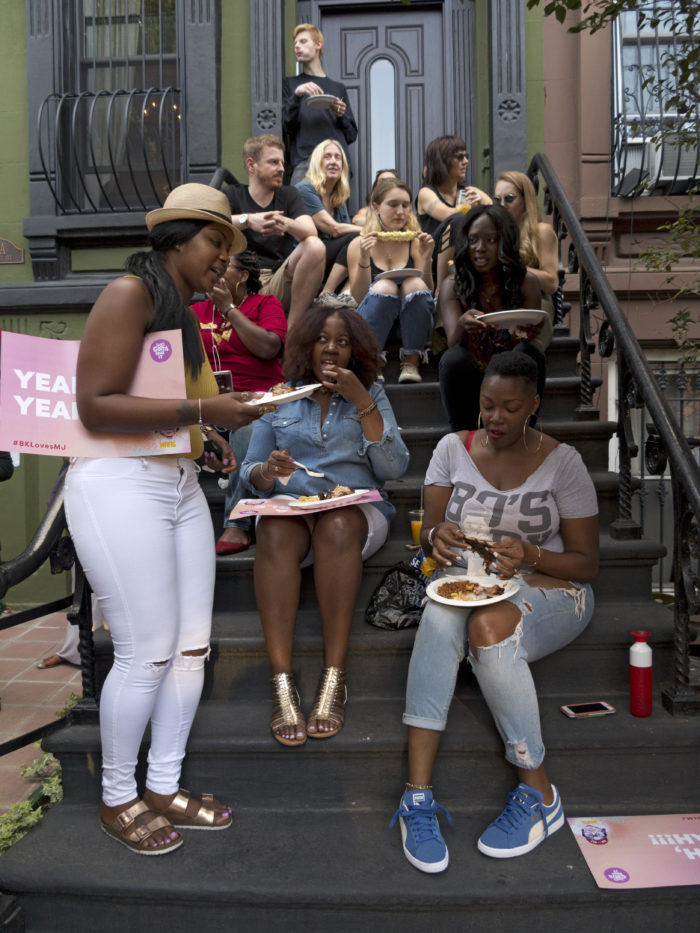
Dining on the stoop during Spike Lee’s annual block party in Bed-Stuy (Photo by Ethel Wolvowitz/Alamy)
In Spike Lee’s speech, he asked, “Have you seen Fort Greene Park in the morning? It’s like the motherfucking Westminster dog show.” The Daily News went to investigate. Under the headline “Brooklyn Residents Don’t Appreciate Spike Lee’s Rants on Gentrification,” they interviewed newcomers to Fort Greene, all out walking their “fancy pooches.” They talked to one 25 year year old with an English Springer Spaniel she’d named Hudson, presumably after the river. A farm-to-table restaurant owner, she’d just moved to Fort Greene from the Hamptons. She told the paper, “I don’t see a negative to cleaning up a neighborhood. … I think it’s a creative bunch of people doing interesting things. It’s all good intentions.” Had she never heard about the road to hell and its paving stones?
Another young person walking her miniature poodle said, “people have the right to live wherever they want to live.” And a third, a jewelry designer and dog walker from Toronto, agreed that the perks of gentrification far outweigh the drawbacks. “I benefit from it,” she said. “I can have a decent cup of coffee.”
Like these pioneers, many people didn’t like what Spike Lee had to say. He was too angry, said online commenters and journalists. They called him “arrogant” and didn’t like the fact that, like television’s George Jefferson, he had moved on up to the Upper East Side. He was a wealthy hypocrite who abandoned Brooklyn, they said, and besides, “White people were there first.” In an op-ed for the Daily News, journalist Errol Louis made some good points about Lee’s role in the gentrification of Brooklyn, including flipping several properties and participating in the marketing of “Absolut Brooklyn” vodka.
There were definitely conflicts that Lee did not address during that Q&A at Pratt, but that does not fully explain the angry, racially toned backlash he received, and the fierce pro-gentrification cries that swirled around him. Plenty of other financially successful New York artists had railed against gentrification—David Byrne of Talking Heads, whose net worth is estimated at $45 million, even used the word “fuck” in a rant against the urban rich—and they didn’t get such backlash. But they weren’t black people expressing anger about white people moving to Brooklyn, the ultimate urban frontier of the 21st century.
From the book VANISHING NEW YORK: How a Great City Lost Its Soul, by Jeremiah Moss. Copyright ©2017 by Jeremiah Moss. Reprinted by permission of Dey Street Books, an imprint of HarperCollins Publishers